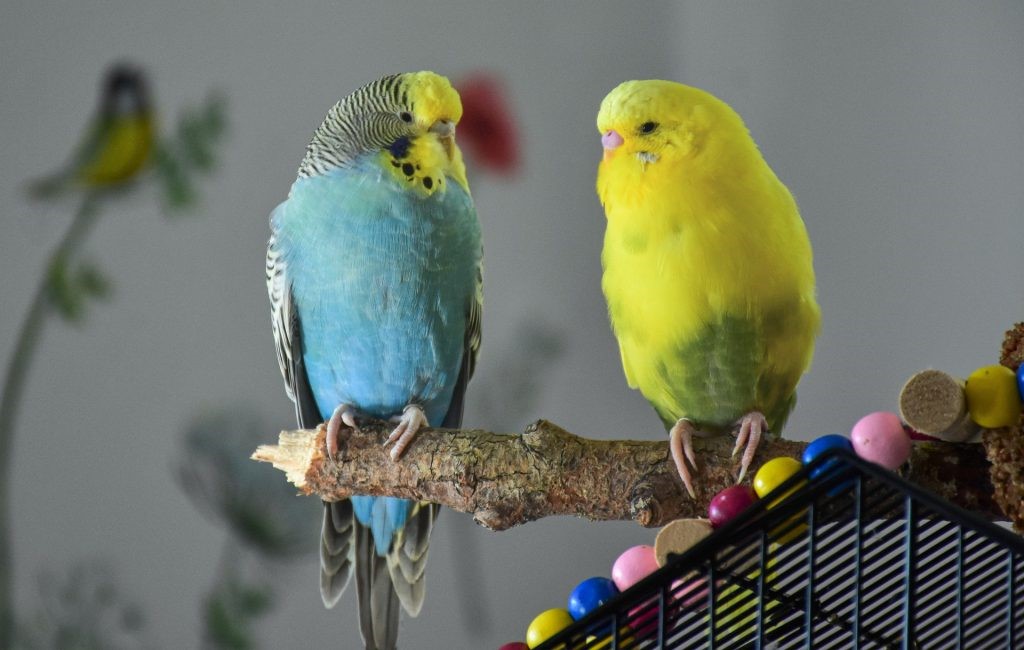Best Indian Pet Birds for Beginners
In India, people have always been inclined toward birds for a very long time. Birds are very popular as pets in India. They are adorable, interactive, smart, and friendly-thus very well suited as companions.
Can I keep birds legally in India?
The Wildlife Protection Act says that no one can keep wild birds that are native to India as pets. Anyone taking care of such birds must either hand them over to the forest department or release them in forests, lakes, and parks.
In India, local birds are not supposed to be kept as pets. But, exotic birds such as budgerigars and cockatoos are allowed to be kept as pets. It is common for people to keep parrots as pets but this is illegal, as is keeping mynas and finches that are trapped in the wild and sold in markets.
What are the best pet birds in India?
You might think this is a simple choice but it isn’t.
You cannot select any bird you want as a pet in India, due to stringent wildlife regulations, one cannot have any bird as a pet in India. Birds that are native to India cannot be kept as pets, and neither can birds which are on the endangered species list.
Here are some advantages to having a pet bird in your home.
Reduces stress: In an age where we are constantly trying to get somewhere and being something we take on a lot of stress, which leads to a lot of health issues. Playing, talking or just interacting with your chosen bird is a lovely way to relieve stress.
Great Companions: For children, adults, people who live alone are wonderful pets. They are always willing to listen and probably have a word or two to say to you as well.
Increases Empathy: It has been researched that if you have a pet that clearly understands your feelings and having you do the same thing for it, it increases empathy in children.
Social Interaction: Having pet birds might require you to connect with other bird pet owners and encourage social interaction
Easier to maintain: Unlike dogs, birds don’t need to be walked. Many smaller pet birds don’t need large living spaces, so they make for good pets for people who live in small houses or apartments. Birds are naturally self-sufficient animals.
Cheaper to maintain: Birds need an annual veterinary check up as they get older, but they do not require vaccinations as long as they are healthy. Feeding them is also relatively inexpensive when compared to a dog or cat.
Intelligent pets: Birds are very intelligent and can be taught to talk if you or your family have a little bit of patience. They are extremely social and enjoy spending time with their owners playing, chatting and eating. They are great at performing tricks and playing games.
Easy First time pet: Birds make great first pets. They can easily adapt into households with children and will teach children responsibility.
Loyalty: If they have been raised by humans, they form really close bonds with their owners and look at them as part of their flock and become extremely sociable, warm and loving.
Bird for your family: Birds come in so many colours with so many different species specific personalities. After your research you can find one that suits your needs as a family.
Some cons to consider before you get a bird as a pet
- Birds can be noisy
- Birds can be messy
- Birds fly away and escape
- Birds need attention especially if you are getting only one of its kind
- Owning a bird is a lifetime commitment
- Not all birds talk
- Birds and cats or your other pets may not get along and you will have to devote time to supervise their interactions before you leave them alone with each other
Best Indian Pet Birds for Beginners
Zebra Finchesas pets
- Size of adult: 4 inches at the most
- Life span: 2 – 3 years
- Breeding: Easy
- Care level: Beginner
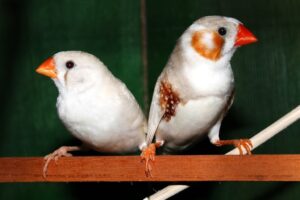
A male and female Zebra Finch
Origin & Characteristics of Finches
Zebra finches live in large flocks and they are native to central Australia and Indonesia. They live around grasslands and forests, preferably close to water. The zebra finches are tiny, but they are not the smallest. They get the name from the zebra-like stripes across its neck, chest, and especially from its black and white barred tail.
They are small birds that are active and fun to watch. They may be small but they require a large cage to fly around. They are social birds and in the wild live in flocks so ideally we would suggest you keep two pairs. They breed readily so we suggest if you don’t want to have too many baby finches then keep all four females or all males.
In our house though we have always kept 2 males and 2 females together. Even though they are social they do not bond strongly with people. They become friendly but they do not like to be handled.
When it comes to vocalisation, they make quiet chirps and peeps that are very sweet. This species should be suitable for apartments or condominium living.
How to tell male and female finches apart
The commonly coloured males are grey with a black tear drops at their eyes and bright red rouge patches on their cheeks and bright red beaks at maturity. The females are more muted in colour with paler orange beaks. There are different mutations that are seen in Zebra finches. They come in pied, fawn, cream, white, and other kinds of mutations. It is then better to buy a flock of these birds so that way you can tell the pairs apart.
How to care for Zebra Finches
Finches may be small but they are very active and they need a lot of exercise flying. We suggest you get a long, large cage that provides enough space for them to fly up and down and side to side. Include a few perches at different heights. Do not over clutter their cage.
Place their cage in a quiet place, unlike parrots they do enjoy as much social integration with humans. As long as they are two or three of them in a cage they are pretty happy on their own. You can interact with them by calling them by their given names and they are likely to respond when you put in food and water.
Finches are foragers and in the wild they eat a lot of seeds. At home you can give them a mixture of seeds, pellets, fruits and veggies, sprouted seeds, egg meal and cuttlefish bone/mineral block for their calcium requirement. Most store bought finches are happy with seeds and will at first be reluctant to eat anything else but we suggest you keep trying. Lots of fresh clean water is important.
Keeping the cage clean is vital. Clean the cage on a regular basis and remove any stale fruits or veggies.
Finches are very susceptible to mites. Giving them a large deep bowl so they can bathe might help with mites. If you see your finch is not doing too well then you might want to isolate it. In our experience we have never isolated them. They are very social birds and without their flock they are as good as dead. So provide them a comfortable box within the cage where it can sit quietly and recoup. We have had 80% successful comebacks.
Breeding habits of finches
Zebra finches are so easy to breed. It is actually difficult to stop them! All they need is a pot or a nesting basket with nesting material and they are settled. Finches are ready to breed when they are about 8 to 10 months of age. It is important to give them a breeding break, the parents can get very tired and die out of exhaustion.
The breeding parents, and the babies, love egg food which you can buy online or make at home. Our suggestion is to strike up a deal with your pet shop guy to exchange finches to prevent interbreeding of your finches.
Budgies / Budgerigars as pets
- Size of adult: 6 – 7.5 inches (18-20 cm)
- Life span: 5 – 8 years
- Breeding: Easy
- Care level: Beginner
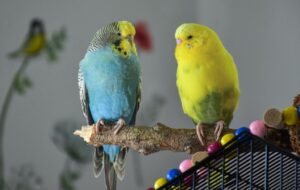
Budgies make colourful delightful pets.
Origin & Characteristics of Budgies
Budgies are parakeets but not all parakeets are budgies. They are also called Budgerigars. In the wild you will find budgies in Australia. There are two types of Budgies. The wild budgies and the English Budgies. The wild budgies were taken as pets and through a process of selective breeding over many years humans created mutations of the wild budgies. In the wild the budgies are green with a yellow head. Our pet budgies can come in many colours and are larger in size than their wild counterparts.
Budgies are gentle and docile birds. They are intelligent, playful and very active. They are also very easy to tame. They are social birds and love to interact with humans and with their own kind. Budgies express themselves with sweet sound harmonies and are excellent talking parrots
How to tell the gender of budgies
The most distinct gender difference that can be identified in a budgie is by looking at the cere. This is the portion where the nostrils are located. In males the cere is bright blue and in females the cere is chocolate brown. This is most prominent when the two are ready to breed. Gender difference can be identified when the budgies are about 6 – 7 months old. The male will move from a pink cere to a purplish colour and a female around the same time you can see the pink cere transitioning to white.
Caring for Budgies
Budgies do not take up too much space but they need to have enough exercise. Give them a cage which is large and spacious with perches at different levels. They love toys and if you do not have enough time to spend with them giving them a companion is a good idea. Budgies get bored and depressed.
Lot of clean water, cuttlefish bone or a mineral block should be always available. Food is easily available at pet stores and on amazon. Their diet should comprise seeds, sprouted seeds, fruits, veggies and leafy veggies. Also just to balance it out add pellets to their diet .
It is important to note that based on the diet you feed your budgies and the space they have to exercise directly reflects on their health. Budgies that only eat seeds develop fatty tumours and liver and kidney issues.
A clean cage is vital. Regular cleaning and daily removal of stale food is a must.
Breeding habits of budgies
Breeding budgies is simple enough. The courting happens, the female gives in and the mating will begin. All you need to do is to provide a nesting box with a concave bottom for the female to lay her eggs. This will happen 8 – 10 days after mating.
The female can lay anything from 4 – 7 eggs in a clutch. It is important to keep food, water constantly available. A mineral block too. The male will feed the female and in turn the female will feed the chicks. The chicks will be ready to come out of the box in 6 weeks time.
Lovebirds as pets
- Size of adult: 6 – 7 inches
- Life span: 15+ years with proper care
- Breeding: Easy
- Care level: Beginner
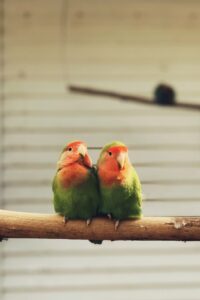
Lovebirds, kept together, become inseparable
Origin & Characteristics of Lovebirds
Lovebirds are found in Africa and Madagascar. Lovebirds are known for their loving, attentive bond they tend to form with their mates. Lovebirds are also known as pocket parrots. Lovebirds have short and rather blunt tail feathers, This is what separates them from budgerigars.
Lovebirds also have a more stockier build. They come in many colours from peach to teal, white to green. They all seem to have brighter head and face colours when compared to the rest of their body feathers.
They have a mild temperament and they are very active, charming, can be loving, curious, playful, and feisty birds. You can form a great bond with lovebirds. But you need to tame them properly because they can be aggressive otherwise. Handling and paying attention to your lovebirds every day and from a very young age is important. If not, these birds can get nippy.
Unlike other parrot species, lovebirds aren’t known for being talkers. They are not very good at mimicking speech or sounds. They like to chatter and chirp.
Gender differences between Lovebirds
It is very hard to tell the difference between the male and female in most lovebird species. In some species the females can show a muted colour when compared to the male. If you absolutely need to know what gender you have here are a few pointers:
You can do a DNA test which should be available at your veterinarian. Another way is to feel the pelvic bone of your lovebirds. If the gap between the pelvic bone is large then it is a female but this is usually distinguishable only after the first egg laying.
You may be able to determine your lovebirds’ gender identity by observing their behaviour. Females will display nesting behaviour, such as tearing up or shredding items that are put in the cage.
If lovebirds are kept in a pair, they tend to form an intense bond with each other. It has nothing to do with the sex of the lovebirds is. Lovebirds kept together for a long period of time will become inseparable.
Caring for Lovebirds
Like all parrots or parakeets, lovebirds are largely seed eaters in the wild. At home we should provide them with a variety of food with fresh fruits and vegetables and cuttlefish bones or a mineral block. Seeds should be given in moderation and a variety of them. Sprouted seeds are also good. Pellet food available online is a good addition. Clean water is a must
A good sturdy, long cage is a good idea for these birds. The longer the cage the better. Length over height we say. They are playful, curious and inquisitive little birds and love to chew things and goof around. Give them loads of toys to play with. If your tamed lovebird is allowed to roam free in your house please ensure that there are no dangers or you are there to supervise their playtime. The silly birds can get themselves entangled in big messes, tear clothes, poke holes and chew. In hindsight, it is very sweet but at the moment it might not be. Don’t say we didn’t warn you!
Breeding habits of Lovebirds
Breeding lovebirds is pretty easy. Once you have a confirmed male and female pair they will pretty soon get down to mating. In their cage provide a nesting box and provide them with enough nesting material paper that they can tear, grass, sawdust etc.
Shortly after mating the female will lay eggs. She can lay anything from 4 – 8 eggs in one clutch. It has been noticed the sooner you take the chicks out and start handling them the more comfortable they will be human handling. If hand taming is your agenda then start taking the chicks out when they are about two weeks old. You could even separate them from their parents and go the whole hand feeding route. The chicks are usually independent when they are about 8 weeks old.
Cockatiels as pets
- Size of adult: 12 inches
- Life span:15 to 20 years
- Breeding: Easy
- Care level: Beginner
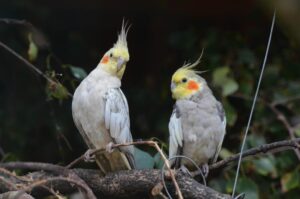
Cockatiels are intelligent birds that learn to mimic common household sounds
Origin & Characteristics of Cockatiels
Cockatiels are native to Australia, but now they are available in most parts of the world. Cockatiels are small parrots with a variety of colour patterns, head crest and mimicking sounds. They are the smallest from the cockatoo family and exhibit many of the same features and habits as the larger bird.
Some common variations are albino, lutino, pied, pearl, laced or opaline, cinnamon, fawn or Isabelle and silver. There are other mutations including emerald, creamface, pastelface, whiteface and yellow cheek cockatiels.
Cockatiels can be gentle, affectionate and have friendly personalities. Cockatiels can also be curious and feisty. It is best to get these birds when they are young and raise them in a loving environment. These birds are exceptionally intelligent and make great pet birds.
These birds may not talk but they are very sharp and intelligent and may learn to mimic common sounds, such as of a doorbell, phone, alarm clock, etc
Gender Differences between male and female cockatiels
The grey wild-type cockatiels are easily distinguishable. The males have a yellow face while the females are a muted grey almost all over. The males lack spots and barring on the undersides of their wings and tail feathers. Now there are so many mutations and in some cases they are very hard to distinguish.
Also the young males also look like adult females carrying the marking and under their wings. This lose only after they first moult which happens when they are about 10 – 12 months of age.
Caring for Cockatiels
Cockatiels like parrots need a large, spacious cage and toys to play with. Add a number of perches varying in sizes and texture. Make sure the cage is sturdy and secure. These birds are very intelligent.
Cockatiels need a varied diet of seeds, sprouted seeds, fresh fruits and vegetables. Like any other bird they need fresh clean water available and cuttlefish bone or mineral block available to them. They are not over-eaters and unlike other parrots are meagre eaters. To get them to change a seed based diet you require to keep giving them variety. Addition of pellet food will help add variety and nutrition.
The cage needs to be cleaned out regularly and uneaten vegetables and fruits should be removed the same day.
Breeding habits of Cockatiels
A mature male and female will quite easily mate and breed. Provide them with a nice large nesting box and give them nesting material. Within a few days of mating the female will lay eggs and the clutch size can vary from 6 – 8 eggs.
The female needs to be given a lot of fresh fruit and vegetables and a mineral block to help supplement for the loss of the nutrients lost while laying her eggs. If you want the cockatiels to be hand tamed the sooner you start handling them the better. At the age of two weeks you can separate them from their parents and start hand feeding them.
You can alternatively take them out and handle them for 30 minutes each and put them back with their parents. By the 8th week the cockatiels are weaned off and are quite independent.
FAQs
Is it legal to keep birds as pets in India?
In India, as per the Wildlife Protection Act (1972), exotic birds that are not native to India can be kept as pets while the local birds are categorized under wild animals and are illegal to keep as pets. In short, We cannot keep local birds as pets but foreign exotic birds like Cockatoos and Budgerigars can be kept as pets.
Are parrots legal in India?
No, parrots are native birds of India and cannot be kept as pets.
Is Love Birds legal in India?
Lovebirds originated in South Africa & Madagascar and are not native to India. They are not covered under the Indian Wildlife Act but are banned from trade in India.
Can we keep Peacock at home in India?
No, since the Peacock is included in the Schedule I species in the Wildlife (Protection) Act and is also the National bird of India, keeping the peacock at home as a pet is illegal in India.
How to make a bird like you and form a bond with you?
Usually, pet birds are easy to connect with their owners, but some may take longer to like you. To form a bond with your pet bird, approach them slowly, use soft speech, and comfort, and offer their favorite treat.
What are the best pet birds for beginners in India?
You can consider finches or canaries if you have no experience with birds before.
What is the punishment for keeping illegal birds in India?
If the bird is categorized under Schedule 1 then the accused can be punished with 7 years of imprisonment or a penalty of up to Rs. 25,000 or both.
Do I need a license to own a pet bird in India?
No, you do not need a license to own a pet bird in India. However, if you plan to sell or breed birds, you may require a license from the local authorities.
What are some common pet bird species in India?
Some common pet bird species in India include budgerigars (also known as parakeets), cockatiels, lovebirds, African grey parrots, and macaws.
Can I keep a wild bird as a pet in India?
No, it is illegal to keep free wild birds such as parrots and pigeons as pets in India without the required permits and licenses.
Can I import pet birds into India?
Yes, it is possible to import pet birds into India, but you will need to follow the procedures and requirements set by the Indian government. Importing certain bird species may also require additional permits and licenses.
What should I do if I find a lost or injured bird in India?
If you find a lost or injured bird in India, it is best to contact local animal welfare organizations or bird rehabilitation centers for assistance. It is illegal to keep wild birds as pets without the proper permits and licenses, and attempting to care for them without the necessary knowledge and experience can be harmful to the bird.
Compiled & Shared by- Team, LITD (Livestock Institute of Training & Development)
Image-Courtesy-Google
Reference-On Request.


